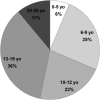Developing multidisciplinary clinics for neuromuscular care and research
- PMID: 28632945
- PMCID: PMC5656914
- DOI: 10.1002/mus.25725
Developing multidisciplinary clinics for neuromuscular care and research
Abstract
Multidisciplinary care is considered the standard of care for both adult and pediatric neuromuscular disorders and has been associated with improved quality of life, resource utilization, and health outcomes. Multidisciplinary care is delivered in multidisciplinary clinics that coordinate care across multiple specialties by reducing travel burden and streamlining care. In addition, the multidisciplinary care setting facilitates the integration of clinical research, patient advocacy, and care innovation (e.g., telehealth). Yet, multidisciplinary care requires substantial commitment of staff time and resources. We calculated personnel costs in our ALS clinic in 2015 and found an average cost per patient visit of $580, of which only 45% was covered by insurance reimbursement. In this review, we will describe classic and emerging concepts in multidisciplinary care models for adult and pediatric neuromuscular disease. We will then explore the financial impact of multidisciplinary care with emphasis on sustainability and metrics to demonstrate quality and value. Muscle Nerve 56: 848-858, 2017.
Keywords: advocacy; disease outcomes; genetics; healthcare costs; multidisciplinary care; telehealth.
© 2017 The Authors Muscle & Nerve Published by Wiley Periodicals, Inc.
Figures




Similar articles
-
Multidisciplinary Clinics in Neuromuscular Medicine.Continuum (Minneap Minn). 2023 Oct 1;29(5):1585-1594. doi: 10.1212/CON.0000000000001340. Continuum (Minneap Minn). 2023. PMID: 37851044
-
The Use of Telehealth to Enhance Care in ALS and other Neuromuscular Disorders.Muscle Nerve. 2020 Jun;61(6):682-691. doi: 10.1002/mus.26838. Epub 2020 Apr 16. Muscle Nerve. 2020. PMID: 32297678 Free PMC article. Review.
-
Improving service delivery for neuromuscular diseases: a survey of consumers at a tertiary Australian hospital.Intern Med J. 2018 Dec;48(12):1520-1524. doi: 10.1111/imj.14123. Intern Med J. 2018. PMID: 30517984
-
Telehealth applications for outpatients with neuromuscular or musculoskeletal disorders.Muscle Nerve. 2018 Oct;58(4):475-485. doi: 10.1002/mus.26115. Epub 2018 Apr 17. Muscle Nerve. 2018. PMID: 29510449 Review.
-
Optimizing value utilizing Toyota Kata methodology in a multidisciplinary clinic.J Pediatr Urol. 2015 Aug;11(4):228.e1-6. doi: 10.1016/j.jpurol.2015.05.010. Epub 2015 Jun 19. J Pediatr Urol. 2015. PMID: 26169487
Cited by
-
Difficulties in social cognitive functioning among pediatric patients with muscular dystrophies.Front Psychol. 2024 Jan 4;14:1296532. doi: 10.3389/fpsyg.2023.1296532. eCollection 2023. Front Psychol. 2024. PMID: 38239460 Free PMC article.
-
Congenital or Early Developing Neuromuscular Diseases Affecting Feeding, Swallowing and Speech - A Review of the Literature from January 1998 to August 2021.J Neuromuscul Dis. 2022;9(5):581-596. doi: 10.3233/JND-210772. J Neuromuscul Dis. 2022. PMID: 35848032 Free PMC article. Review.
-
Crossing barriers: a multidisciplinary approach to children and adults with young-onset movement disorders.J Clin Mov Disord. 2018 Apr 6;5:3. doi: 10.1186/s40734-018-0070-x. eCollection 2018. J Clin Mov Disord. 2018. PMID: 29636982 Free PMC article.
-
Priorities and Recommendations to Make ALS a Livable Disease Emanating from the 2024 National Academies of Sciences, Engineering, and Medicine Report Living with ALS.Ann Neurol. 2024 Dec;96(6):1035-1039. doi: 10.1002/ana.27097. Epub 2024 Oct 10. Ann Neurol. 2024. PMID: 39390661 Review.
-
Practical Approaches and Knowledge Gaps in the Care for Children With Leukodystrophies.J Child Neurol. 2021 Jan;36(1):65-78. doi: 10.1177/0883073820946154. Epub 2020 Sep 2. J Child Neurol. 2021. PMID: 32875938 Free PMC article. Review.
References
-
- Miller RG, Jackson CE, Kasarskis EJ. Practice parameter update: the care of the patient with amyotrophic lateral sclerosis: multidisciplinary care, symptom management, and cognitive/behavioral impairment (an evidence‐based review): report of the Quality Standards Subcommittee of the American Academy of Neurology. Neurology 2009;73:1227–1233. - PMC - PubMed
-
- Bushby K, Finkel R, Birnkrant DJ. Diagnosis and management of Duchenne muscular dystrophy, part 2: implementation of multidisciplinary care. Lancet Neurol 2010;9:177–189. - PubMed
-
- Wang CH, Finkel RS, Bertini ES. Consensus statement for standard of care in spinal muscular atrophy. J Child Neurol 2007;22:1027–1049. - PubMed
-
- Kang PB, Morrison L, Iannaccone ST. Evidence‐based guideline summary: evaluation, diagnosis, and management of congenital muscular dystrophy: report of the Guideline Development Subcommittee of the American Academy of Neurology and the Practice Issues Review Panel of the American Association of Neuromuscular & Electrodiagnostic Medicine. Neurology 2015;84:1369–1378. - PMC - PubMed
Publication types
MeSH terms
LinkOut - more resources
Full Text Sources
Other Literature Sources
Medical
Miscellaneous

